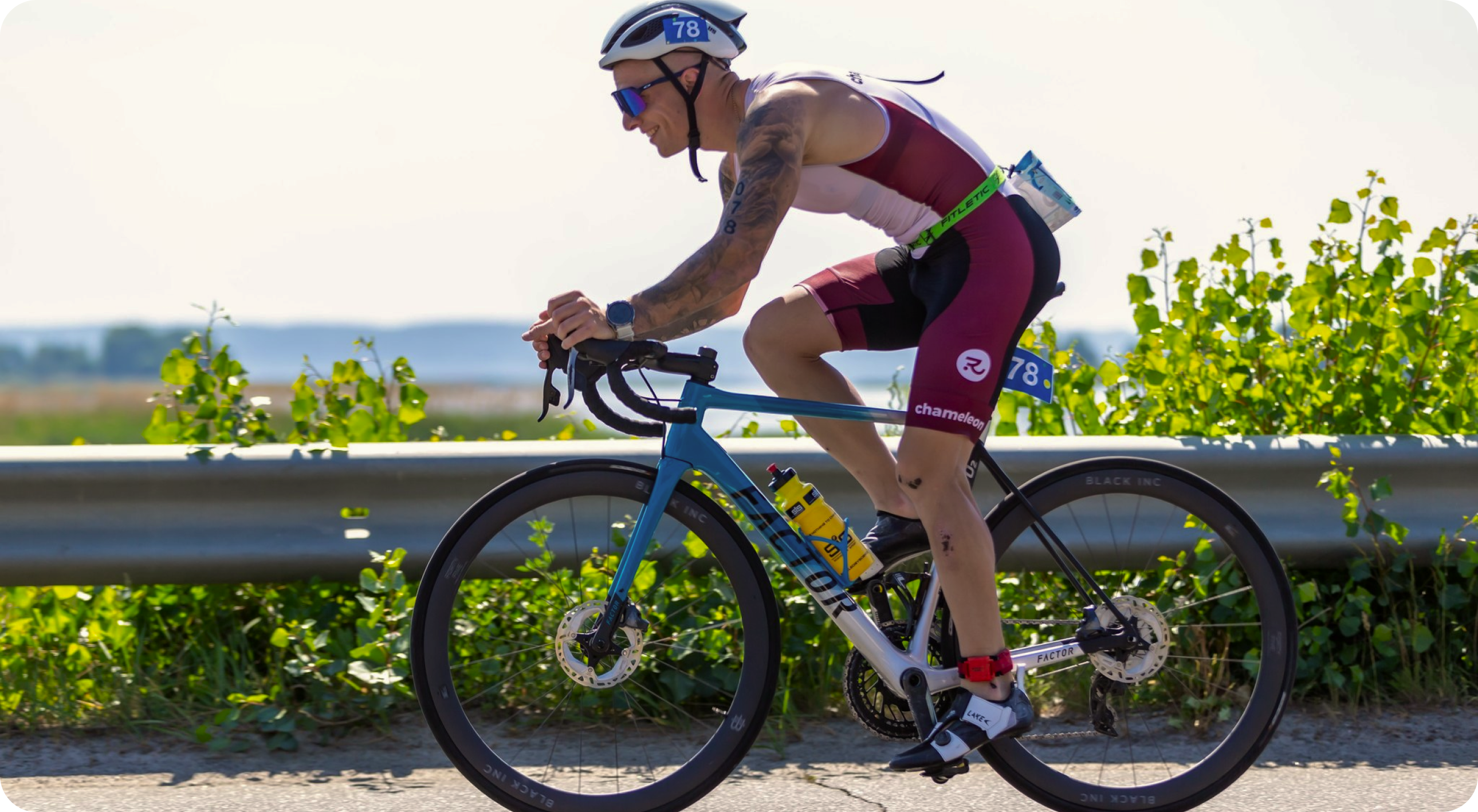Triathlons have captured the imagination of athletes around the world.
In this field, where seconds can separate triumph from defeat, the importance of equipment comes to the fore.
Meet our hero, a dedicated triathlete whose quest for excellence has led him on a profound journey of self-discovery and optimal performance.
At the heart of this journey is a key decision: carefully choosing the perfect triathlon bike.
This article delves into their story, revealing the symbiotic relationship between athlete and machine.
The Triathlete’s Dilemma: Balancing Performance and Investment
The triathlete’s journey begins with the first bike – a fundamental choice that marks the beginning of the sport.
However, as skills develop, the limitations of the first bike become apparent.
The initial bike, chosen for its practicality and affordability, became a stepping stone.
It helped them to take their first steps, movements and pedal.
However, as they honed their technique and dreamed of crossing the finish line at new speeds, the limitations of that first bike became apparent.
This narrative reflects a common problem faced by triathletes.
Namely, the balance between budgetary constraints, the large number of bike options, and the need to improve their performance.
1. Budget Constraints
Financial realities are at the heart of this challenge.
Triathlons require skill in swimming, cycling, and running.
The total cost can be significant. Triathlon creates financial stress for novice athletes.
It requires excellence in three different disciplines.
The allure of state-of-the-art equipment is undeniable, but the reality of financial responsibility is no less compelling.
2. A Large Number of Bicycle Options
Navigating the variety of bicycle options further complicates the dilemma.
From streamlined designs to endurance-oriented models, triathletes face a maze of choices.
From sleek, aerodynamic machines to bicycles. A triathlete is faced with a lot of options.
Finding the right fit requires understanding the nuances of each option while keeping budgetary constraints in mind.
3. The Need to Improve Your Results
First of all, athletes are driven forward by the desire to improve their results.
Every stroke, pedal, and step is fueled by the desire to surpass their own records.
The optimal bike becomes an important partner in turning this ambition into results.
This is the background of the triathlete’s journey.
Specifically, a journey into the world of triathlon bikes, where the combination of technology and sport redefines what is possible.
Let’s dive deeper into understanding the specifics of triathlon bikes.

Researching the Perfect Match: Understanding Triathlon-Specific Bikes
The pursuit of excellence in triathlon goes beyond physical perfection is inextricably linked to the equipment that propels athletes toward their goals.
Triathlon bikes are not just bikes.
They are engineering marvels designed with precision to overcome air resistance and optimize energy transfer.
Their importance lies in their ability to reduce drag, which is a crucial factor.
It can have a significant impact on speed and energy savings over long distances.
With design elements such as an aerodynamic frame shape, integrated handlebars, and specialized wheelsets, these bikes are carefully crafted to take advantage of all available benefits.
Statistics on the Impact of Bike Choice
Statistics emphasize the transformative potential of choosing the right bike.
Studies have shown that the right triathlon bike can result in significant time savings.
A study conducted by the International Journal of Sports Science & Coaching found that optimal triathlon bicycles selection can contribute to an average of 6-10 minutes of time gain over the standard Olympic triathlon distance.
This statistic emphasizes the relationship between equipment accuracy and race success.
This is evidence of the profound impact of technology in this discipline.

Factors That Influence the Choice
As we delve into the science behind these triathlon bicycles, we encounter a complex dance of bike geometry, frame materials, and component selection.
1. Bike Geometry
A bike’s geometry, which includes frame angles, dimensions, and positioning, shapes not only aerodynamics but also comfort and handling.
An aggressive geometry with steep seat tube angles and low handlebars improves aerodynamics.
But it must be balanced with the athlete’s comfort during the harsh conditions of a triathlon.
2. Frame Materials
Frame materials are another important factor.
Prized for its lightness and stiffness, carbon fiber dominates the production of high-performance triathlon bikes.
Its ability to balance between the stiffness and elasticity needed for energy transfer and shock absorption has become the gold standard.
3. Component Selection
The choice of components, from the drivetrain to the wheels, is the final piece in this complex puzzle.
High-quality components not only increase performance but also ensure reliability – a paramount factor in the unforgiving world of triathlon.
In this quest for optimal performance, triathlon bikes become the pivot, a symphony of design, technology, and athleticism.
The profound impact these bikes for triathlon have on triathlon performance is not just anecdotal.
It’s backed by data, research, and the experiences of athletes who have seen their times improve and their podium dreams materialize.
As we continue this journey, we delve deeper into the quest of triathletes, and how professional consultation can improve the connection between athlete and machine, ultimately leading to transformative improvement.
Consulting the Experts: Seeking Professional Guidance
As our triathlete embarks on his journey to improve his performance, he makes a key decision to seek the advice of experienced cycling experts.
This choice is not just a recognition of experience. It is a strategic move that opens up a new dimension of potential.
Recognizing the complexity of the decision-making process, the triathlete embarks on a mission to tap into the wealth of knowledge.
This knowledge is held by cycling experts.
By listening to expert advice, the triathlete is setting a course for a deeper understanding of the symbiotic relationship between the athlete and the triathlon bicycles.

Benefits of Visiting a Bike Shop
A visit to a specialized bike shop is the first step on this path to enlightenment.
Here, the experience takes on a tangible form as mechanics and staff offer personalized recommendations based on the athlete’s goals, riding style, and body mechanics.
1. Professional Bike Setup
A professional bike fit transforms a triathlete’s understanding of how the bike and their body work together.
Fitting a bike is an art that includes adjusting the saddle height, handlebar reach, pedal position, and much more.
The result is a bike that is not just a tool, but an extension of the athlete.
2. Understand the Nuances of Bike Components
Understanding the nuances of the bike’s components becomes a crucial aspect of this education.
In addition to aesthetics, the triathlete delves into the intricacies of the drivetrain, brakes, wheels, etc.
This knowledge enables them to make informed decisions about component upgrades that meet their competitive goals.
The triathlete comes away from this experience not just with a triathlon bike, but with an education that enhances their understanding of the sport.
Moving on to the next section of this article, we will explore the transition period from the old triathlon bike to the new.
Training with Precision: Adapting to the New Bike
With the choice of a new triathlon bike comes a transition period – a bridge from the familiar to the uncharted territory of improved performance.
This stage is not just a technical change.
It’s a transformation of technique and mindset, where the athlete uses the bike’s capabilities to rethink their approach to training.
Switching from an old triathlon bicycle to a new one is more than just changing the frame.
It’s about adapting to a machine that responds differently to every pedal stroke and weight change.
The usual routine of getting the bike on and off, the feel of the handlebars under your hand – all of this has to be rethought, taking into account the nuances that are unique to a new bike.

Challenges Are Inherent in This Stage
The fascination with speed and aerodynamics can go hand in hand with a learning curve that reveals aspects of the bike’s handling that are different from the previous ones.
Sharp turns, hard braking, and the nuances of the aero bar all create new obstacles to navigate.
As a triathlete becomes more familiar with the triathlon bicycles, so does his or her confidence in the ability to conquer new heights.
When the adaptation phase comes to an end, a new and final phase begins – the race day revolution, when the triathlete’s transformation is put to the ultimate test.
Beyond the Finish Line: Lessons Learned and Future Prospects
The culmination of a triathlete’s journey reveals a tapestry woven from threads of commitment, choice, and transformative results.
The decision to upgrade a bike, which was once just a wish, has now become a catalyst for redefining the entire triathlon experience.
The positive results of the bike upgrade are reflected in every aspect of the triathlete’s journey.
The seamless integration of aerodynamics and efficiency in the new triathlon bike is evident in training.
Where energy is conserved and speed is increased.
The triathlete’s experience emphasizes the critical importance of equipment selection in shaping performance trajectory.
It serves as a reminder that success is not only achieved through sweat and hours of training; it is also the result of strategic choices that enhance an individual’s potential.

Conclusion: Redefining Success through Strategic Choices
In the ever-evolving field of triathlon, the relationship between athlete and equipment remains a dynamic force.
Readers are encouraged to harness the potential of their equipment to enhance their own performance.
When this narrative fades into the background, its essence remains, echoing with a feeling.
The feeling that every choice, every upgrade has the potential to push you over the finish line and redefine what it means to succeed.




